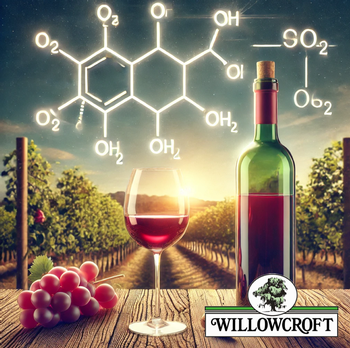Sulfites in Wine: What You Need to Know
 If you're a wine lover, you've likely heard about sulfites and may have some concerns. Let's clear up the confusion and understand what sulfites are, why they're used in winemaking, and whether they're harmful.
If you're a wine lover, you've likely heard about sulfites and may have some concerns. Let's clear up the confusion and understand what sulfites are, why they're used in winemaking, and whether they're harmful.
Sulfites are naturally occurring chemical compounds found in all wines. They are produced during fermentation when yeast converts sugars into alcohol, and winemakers have been adding sulfur dioxide (a form of sulfite) to wine since the 1800s. Sulfites serve several crucial functions in the winemaking process:
- Protecting against oxidation: Sulfites help prevent wine from oxidizing, which can adversely affect its color and taste.
- Preventing microbial growth: Sulfites inhibit the growth of unwanted microorganisms that could spoil the wine.
- Preserving color: Sulfites help maintain the desired color of the wine.
- Enhancing fermentation: Sulfites promote yeast growth, leading to better fermentation.
- Improving flavor extraction: Sulfites assist in releasing desirable compounds from the grape skins and seeds.
Sulfite Levels in Different Wines
Sulfite levels vary among different types of wines. Red wines generally have the lowest sulfite content, while sweet white wines have the highest. Rosé and dry wines fall somewhere in between. Despite these variations, sulfites are present in nearly all wines due to their essential role in preserving wine's freshness and flavor.
Are Sulfites Dangerous?
For the vast majority of people, sulfites are safe. However, some individuals may experience mild allergic reactions, such as headaches or respiratory issues. It's important to note that sulfites are found in wine and many other foods, sometimes in concentrations up to ten times higher than those in wine. These include dried fruits, processed foods, and condiments. Sulfites are even used to keep shrimp and lobster from turning dark, ensuring their appearance and quality are maintained.
European Wines and Sulfites
Many assume that European wines cause fewer headaches because they contain fewer sulfites. However, European wines typically have the same sulfite levels as American wines. The difference lies in labeling laws. In Europe, wineries are not required to place a sulfite warning on their labels, unlike in the United States, where it is mandatory. This labeling difference often leads to the misconception that European wines are sulfite-free or contain fewer sulfites.
Conclusion
Sulfites are critical in ensuring that the wine you enjoy retains its quality, flavor, and safety. While they can cause mild reactions in rare cases, they are generally harmless to wine lovers. Understanding the role of sulfites can help you appreciate the complexities of winemaking and confidently enjoy your next glass of wine. Cheers to a well-preserved wine experience!

